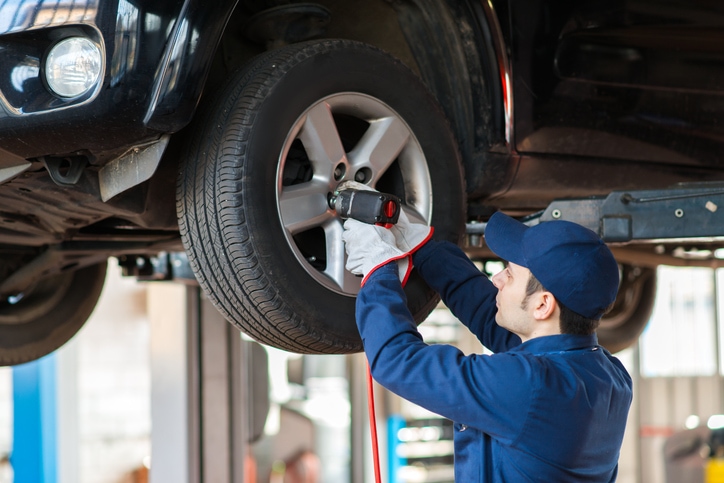All Categories
Featured
Tire turnings might not constantly be top of mind for automobile upkeep, however they play a critical duty in guaranteeing your vehicle's security, efficiency, and longevity. By frequently revolving your tires, you can stop irregular wear, optimize your tires' lifespan, and enhance your driving experience.
What Is Tire Rotation?
Tire turning is the process of relocating tires to different settings on your automobile to guarantee also put on. Depending on your car's drivetrain-- front-wheel drive (FWD), rear-wheel drive (RWD), or all-wheel drive (AWD)-- the front and back tires experience various degrees of stress. Consistently rotating your tires assists distribute this wear evenly.
Benefits of Regular Tire Rotations
Also Tire Use
Tires on various axles experience different levels of stress. As an example, front tires on a FWD automobile handle velocity, stopping, and steering, creating them to put on faster.
Revolving the tires ensures also use, permitting all 4 tires to keep comparable walk depth.
Enhanced Handling and Safety And Security
![]()
Irregular walk depth can cause discrepancies, reduced traction, and jeopardized handling, specifically on unsafe or wet roadways.
Revolved tires make sure consistent performance and a more secure driving experience.
Extensive Tire Lifespan
Also use ways your tires last longer, saving you cash on early substitutes.
Better Gas Performance
![]()
Erratically worn tires can boost rolling resistance, requiring even more energy from the engine and reducing gas economic situation.
Well balanced tires reduce pressure on the vehicle and enhance effectiveness.
Cost Cost Savings
By prolonging the life of your tires and stopping premature substitutes, routine turnings can conserve you considerable prices over time.
Recommended Turning Intervals
The majority of suppliers recommend turning your tires every 5,000 to 7,500 miles. An excellent rule of thumb is to have your tires turned during regular upkeep check outs, such as oil adjustments. Constantly describe your vehicle's owner manual for details standards.
Usual Tire Rotation Patterns
The turning pattern depends upon your car's drivetrain and tire kind:
Front-Wheel Drive: Swap front tires with the back ones, crossing them diagonally.
Rear-Wheel Drive: Move rear tires to the front axle and cross them.
Four-wheel Drive: Use an "X" pattern for well balanced wear.
Directional Tires: Make certain the tires remain on the exact same side to keep their made efficiency.
Indications You Required a Tire Turning
Irregular wear patterns on the tires.
Car resonances, specifically at higher speeds.
Decreased gas efficiency.
Difficulty preserving control in damaging conditions.
Final Ideas
Normal tire rotations are necessary for maintaining your automobile's safety and security and efficiency. By investing time in this uncomplicated treatment, you'll enjoy a smoother adventure, enhanced handling, and significant cost savings in the lengthy run. Arrange your following tire rotation with a trusted provider and make it a regular part of your maintenance regimen.
What Is Tire Rotation?
Tire turning is the process of relocating tires to different settings on your automobile to guarantee also put on. Depending on your car's drivetrain-- front-wheel drive (FWD), rear-wheel drive (RWD), or all-wheel drive (AWD)-- the front and back tires experience various degrees of stress. Consistently rotating your tires assists distribute this wear evenly.
Benefits of Regular Tire Rotations
Also Tire Use
Tires on various axles experience different levels of stress. As an example, front tires on a FWD automobile handle velocity, stopping, and steering, creating them to put on faster.
Revolving the tires ensures also use, permitting all 4 tires to keep comparable walk depth.
Enhanced Handling and Safety And Security

Irregular walk depth can cause discrepancies, reduced traction, and jeopardized handling, specifically on unsafe or wet roadways.
Revolved tires make sure consistent performance and a more secure driving experience.
Extensive Tire Lifespan
Also use ways your tires last longer, saving you cash on early substitutes.
Better Gas Performance

Erratically worn tires can boost rolling resistance, requiring even more energy from the engine and reducing gas economic situation.
Well balanced tires reduce pressure on the vehicle and enhance effectiveness.
Cost Cost Savings
By prolonging the life of your tires and stopping premature substitutes, routine turnings can conserve you considerable prices over time.
Recommended Turning Intervals
The majority of suppliers recommend turning your tires every 5,000 to 7,500 miles. An excellent rule of thumb is to have your tires turned during regular upkeep check outs, such as oil adjustments. Constantly describe your vehicle's owner manual for details standards.
Usual Tire Rotation Patterns
The turning pattern depends upon your car's drivetrain and tire kind:
Front-Wheel Drive: Swap front tires with the back ones, crossing them diagonally.
Rear-Wheel Drive: Move rear tires to the front axle and cross them.
Four-wheel Drive: Use an "X" pattern for well balanced wear.
Directional Tires: Make certain the tires remain on the exact same side to keep their made efficiency.
Indications You Required a Tire Turning
Irregular wear patterns on the tires.
Car resonances, specifically at higher speeds.
Decreased gas efficiency.
Difficulty preserving control in damaging conditions.
Final Ideas
Normal tire rotations are necessary for maintaining your automobile's safety and security and efficiency. By investing time in this uncomplicated treatment, you'll enjoy a smoother adventure, enhanced handling, and significant cost savings in the lengthy run. Arrange your following tire rotation with a trusted provider and make it a regular part of your maintenance regimen.
Latest Posts
The A Touch of Green Style Process: An Individualized Outdoor Experience
Published Apr 03, 25
1 min read
Eco-Friendly Landscape Design: Tips for Lasting Outdoor Spaces
Published Apr 03, 25
1 min read
Secure Your Roofing System from Hail Storm Damages with Aabel Roof Covering
Published Apr 02, 25
1 min read
More
Latest Posts
The A Touch of Green Style Process: An Individualized Outdoor Experience
Published Apr 03, 25
1 min read
Eco-Friendly Landscape Design: Tips for Lasting Outdoor Spaces
Published Apr 03, 25
1 min read
Secure Your Roofing System from Hail Storm Damages with Aabel Roof Covering
Published Apr 02, 25
1 min read